| Formerly |
|
|---|---|
| Company type | Private (1892–1961) Subsidiary (1961–present) |
| Industry | Electronics |
| Founded | 1892; 133 years ago (1892) |
| Headquarters | Philadelphia, Pennsylvania, U.S. |
| Area served | Worldwide |
| Key people | Philo Farnsworth |
| Products | Consumer electronics |
| Parent | Philips (North America), Electrolux (elsewhere) |
| Website | www |
Philco (an acronym for Philadelphia Battery Company) is an American electronics manufacturer headquartered in Philadelphia. Philco was a pioneer in battery, radio, and television production. In 1961, the company was purchased by Ford and, from 1966, renamed "Philco-Ford". Ford sold the company to GTE in 1974, and it was purchased by Philips in 1981. In North America, the Philco brand is owned by Philips. In other markets, the Philco International brand is owned by Electrolux.
In the early 1920s, Philco made storage batteries, "socket power" battery eliminator units (plug-in transformers), and battery chargers. With the invention of the rectifier tube, which made it practical to power radios by electrical outlets, in 1928, Philco entered the radio business. They followed other radio makers such as RCA, Atwater-Kent, Zenith Electronics, Freshman Masterpiece, FADA Radio (Frank A. D'Andrea Radio), and AH Grebe into the battery-powered radio business. By the end of 1930, they were selling more radios than any other maker, a position they held for more than 20 years.
Philco built many iconic radios and television sets, including the classic cathedral-shaped wooden radio of the 1930s (aka the "Baby Grand"), and the Predicta series of television receiver sets of the 1950s.
Philo Farnsworth, credited for inventing the first fully functional all electronic television system (U.S. patent 1,773,980, filed Jan 7, 1927), worked at Philco from 1931 to 1933.
Early history
Philco was founded in 1892 as Helios Electric Company. From its inception until 1904, the company manufactured carbon-arc lamps. As this line of business slowly floundered over the last decade of the 19th century, the firm experienced increasingly difficult times. As the Philadelphia Storage Battery Company, in 1906 it began making batteries for electric vehicles. They later supplied home charging batteries to the infant radio industry. The Philco brand name appeared in 1919.
Radios
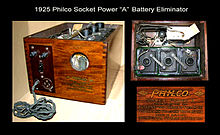
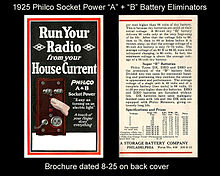
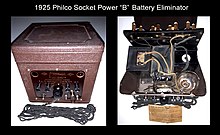
Until the mid- to late-1920s, all radios except crystal sets were powered by vacuum tube batteries which were expensive, needed frequent charging, and leaked battery acid, reducing the wife approval factor in the home. A very successful August 1925 Philco consumer product, called the "Socket Power Battery Eliminator", was a rectifier unit which enabled users to operate radios from standard light sockets. By 1927 over a million of these units had been sold, but from that year the industry began manufacturing batteryless radios using RCA's AC tube. The almost immediate end of demand for battery eliminators forced Philco to quickly design and manufacture its own radios that used household power. The first Philco radios were introduced in mid-1928, and 96,000 were produced that year, making Philco radios 26th in the nation in production volume. Up to that time most radios were handmade and priced for relatively wealthy consumers. Atwater Kent, the leading radio seller, coincidentally was also located in Philadelphia.
The Philadelphia Storage Battery Company decided that prices of radios could be scaled for a mass market by incorporating assembly line techniques then only used by the automobile industry. By the 1929 model year, Philco was in third place behind Atwater Kent and Majestic (Grigsby-Grunow Corp) in radio sales. In 1930, the company sold 600,000 radios, grossed $34 million, and was the leading radio maker in the country. By 1934, they had captured 30% of the domestic radio market.
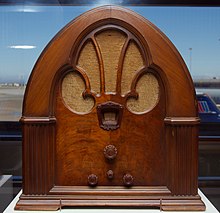
Philco radios were economical without sacrificing quality or durability. Like other makers of the era, they offered a wide line of radios beginning with five-tube sets all the way up to high-fidelity consoles with 20 tubes in 1937–38. Philco also made battery-powered radios which were by then called "farm radios", most of which had cabinets identical to their AC powered versions. The Philco "Baby Grand" (today called "cathedral" radios by collectors) was a shape that featured an arched top that wrapped from the sides over the top. This was for economic reason partly, as one piece of wood formed both the top and sides. Philco sold far more of this style than any other maker, a total of over two million (in over twenty models, with from four to eleven tubes) from 1930 to 1938; many of them exist today in collections. By today's standards, most are still excellent performing AM band radios when restored.
A few of their innovations were very futuristic. From 1939 to 1941, they sold radios that were operated by wireless remote control, the one-tube "Mystery Control", used on their 13-tube model 116RX-SU (or 39-116). This feature was not offered by any other maker until the 1970s stereo receivers. Philco ranked 57th among United States corporations in the value of World War II military production contracts.
Another interesting product was the Philco "Beam of Light" 78 RPM record players offered in 1941 and 1942. These units had a tiny mirror attached to the player's needle. A beam of light was focused on the mirror which caused a vibrating light to hit a photoelectric cell and produce the audio signal. While this system had some advantages over the standard crystal phono cartridge of the time, it was unreliable and is today a very difficult unit to restore.
Expansion
In 1941, in response to outside needs for personnel skilled in electronics, Philco founded a training and installation organization that evolved into its TechRep division, with hundreds of personnel styled as Field Engineers or TechReps in positions worldwide. This division later became the foundation for the Ford Aerospace organization.
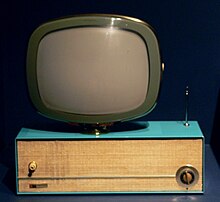
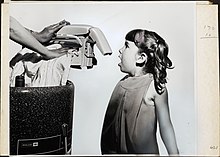
Philco began marketing car radios in 1930 and later expanded into other areas including air conditioners (1938), refrigerators (1939), home freezers (1946), consumer televisions (1947), electric ranges (1949), home laundry washers and dryers (1954), and home entertainment products. Their first consumer television set, the 1948 table Model 48-1000, had a 10 in (25 cm) black-and-white screen and sold for US$395 ($4,482 in 2023).
By 1954, Philco had led the radio industry in sales volume for 24 straight years, selling over 30 million radios.
Philco was also a pioneer in television broadcasting, launching Philadelphia experimental station W3XE in 1932. In 1941, the station became the third commercially licensed TV operation in the United States as WPTZ. It was sold to Westinghouse Broadcasting in 1953 and became KYW-TV, a CBS owned and operated station.
The Philco Predicta TV set was introduced in 1957 for the 1958 model year. It was a black-and-white television with the picture tube mounted in a unique steerable pod on a pedestal. There were many versions: 17" or 21" picture tubes, wood or metal cabinets and table or floor standing versions, some with rare UHF tuners. Its specially designed, high-deflection-angle (to achieve a shallow front-to-back depth) picture tube turned out to be unreliable, and cost the company dearly in repairs and reputation. The 1959 model included a console and a table model. Many of them were sold to motels and bars due to the convenience of the swivel tube arrangement. It was discontinued in 1960; a disappointing failure for Philco. Due to the unique design, the Predicta is a collector's favorite and restored examples can easily be found.
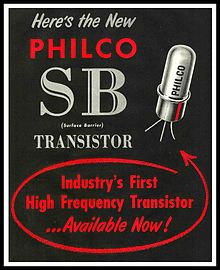
Transistor research and product development
See also: Philco computersIn late 1953, engineers at Philco Corporation invented the surface-barrier transistor, the first high frequency transistor suitable for use in high speed computers. Philco Corporation had produced a late 1950s production film about its surface-barrier transistor manufacturing processes and product developments that was titled, "Philco Transistors - The Tiny Giants Of The Future".
A May 1954 news article describes Philco's development of a pre-production indium-coated transistor that used silicon instead of germanium that relied on further improvements in silicon refinement to bring to production.
In June 1955, the National Security Agency and the United States Navy entered into a contract with Philco to build a specialized scientific transistorized computer based on Philco's surface barrier transistor technology. The project was called SOLO, since the idea was to have powerful personal workstations, and the computer was later commercially named the Philco Transac S-1000. The SOLO transistorized large scale scientific computer was finally built and delivered to the National Security Agency in November 1957. Philco also entered into a contract with the U.S. Navy's David Taylor Basin Research Division in 1955, to build a larger scale fully transistorized computer using its surface-barrier transistor technology, which was named the CPXQ model and later became the Philco Transac S-2000.
Philco had developed and produced a miniature transistorized computer brain for the Navy's jet fighter planes in 1955 and it was called the "Transac" (C-1000, C-1100), which had stood for "Transistor Automatic Computer." The Philco Transac computer brain had used its high-frequency surface-barriers transistors in the circuitry design.
Chrysler and Philco announced that they had developed and produced the world's first all-transistor car radio and it was announced in the April 28, 1955, edition of the Wall Street Journal. Chrysler made the all-transistor car radio, Mopar model 914HR, available in Fall 1955 for its new line of 1956 Chrysler and Imperial cars, as a $150 option ($1,706 in 2023). Philco's radio manufacturing plant in Sandusky, Ohio, had produced the all-transistor car radio unit for the Chrysler Corporation, which also used Philco's surface-barrier transistors in its circuitry design.

In 1955, Philco developed and produced the first all-transistor phonograph models TPA-1 and TPA-2. This was announced in the June 28, 1955, edition of the Wall Street Journal. Philco had begun selling these phonographs in the fall of 1955 for $59.95 ($682.00 in 2023). The October 1955 issue of Radio & Television News magazine (page 41) printed a full-page, detailed article, on Philco's new consumer phonograph. The Philco all-transistor portable phonograph TPA-1 and TPA-2 models played only 45rpm records and used four 1.5v "D" batteries for its power supply. "TPA" stands for "Transistor Phonograph Amplifier". Its circuitry used three Philco germanium PNP alloy-fused junction audio frequency transistors. After the 1956 season ended, Philco discontinued the all-transistor portable 45rpm phonograph models, for transistors were too expensive compared to vacuum tubes.
The Philco Transac models S-1000 scientific computer and S-2000 electronic data processing computer, were the first commercially produced large-scale all transistor computers, which were introduced in 1957. It used discrete surface barrier transistors instead of vacuum tubes (the integrated circuit had not yet been invented). It also used a fast adder, invented by Bruce Gilchrist, James H. Pomerene and Y.K. Wong of the Institute for Advanced Study. It incorporated a speed-up technique for asynchronous adders reducing the time for additive carry-overs to propagate.
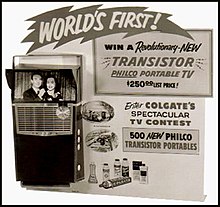
In 1959, Philco developed and produced the first battery-powered portable transistorized TV. This TV model was called the "Safari" and contained 21 transistors. Philco had developed the VHF micro-alloy diffused transistor (MADT) and used them in the Safari portable TV. The retail selling price was $250.00 ($2,613 in 2023) plus the cost of the rechargeable battery, which was $5.25 extra ($55.00 in 2023).
In 1962, the Philco 2000 Model 212 computer was chosen for use in the North American Aerospace Defense Command's famous Cheyenne Mountain Complex. Three of them were installed that year and ran until 1980. They were also used by research labs at Westinghouse Electric and General Electric.
Space systems
In 1960, the Courier 1B, built by Philco, became the first active repeater satellite. Courier 1B was built by the Western Development Labs (WDL) division of Philco, previously known as "Army Fort Monmouth Laboratories" (Fort Monmouth).
In 1960, NASA contracted with Philco to build the worldwide tracking station network for Project Mercury, and all subsequent man-in-space space projects until the ground station network was replaced by the TDRS communication satellites in the 1990s. Philco's Western Development Labs ultimately became Space Systems/Loral, which continues to manufacture spacecraft. In later years, the company produced automotive electronic controls, aerospace tracking systems, and artificial satellites.
In 1963, Philco was also responsible for the design, manufacturing, installation, and service of all the consoles used in both Mission Operations Control Rooms (a.k.a. Mission Control) at Building 30 of NASA's Lyndon B. Johnson Space Center in Houston, Texas. Philco technical representatives worked with NASA staff to design and integrate the consoles with NASA hardware and systems. The consoles were used for the Gemini, Apollo, Skylab, and Space Shuttle missions until 1998. The Philco-designed and installed consoles in Mission Control 2 at the Johnson Space Center have been preserved and will be restored to their Apollo-era configuration for historical purposes. The control room is listed in the National Register of Historic Places as the "Apollo Mission Control Center".
Water purification systems
In 1971, Philco-Ford began to sell reverse osmosis-based water purification systems that used tube-shaped membranes developed by the company to filter and desalinate raw polluted water for municipal utilities and manufacturing.
Demise

On December 11, 1961, Ford Motor Company purchased Philco and continued to offer consumer products, computer systems and defense related projects. The company, which had supplied Ford with some of its car radios as early as the 1930s, continued to provide Ford with car and truck radio receivers; consumer product investments were also made to color television production. Along with color and black and white television, Philco continued to produce refrigerators, washers, dryers, air conditioners, stoves, radios, portable transistor radios, portable phonographs, audio console systems with high quality "Mastercraft" furniture cabinets, and component stereo systems.
The company branded Philco products as "Philco-Ford" in 1966, and console stereo systems reached their zenith during 1966 and 1967, with high quality cabinet construction and powerful stereo chassis systems of 100- and 300-watt consoles. Philco at one time was one of the largest furniture producers in the world, but the end was near for "high quality" furniture cabinets along with stereo equipment. Solid wood cabinets with veneers were replaced with cheaper wood composites covered in vinyl paper and plastic wood pieces. The quality electronic systems that had been built in the United States were replaced with new designs and systems, engineered and built at a plant owned by Philco-Taiwan. Eventually, all consumer electronic goods would be made by Philco-Taiwan, to lower costs of production and be more competitive in the market. The prevailing industry trend was to move consumer electronic manufacturing to Asia in order to lower the cost of labor and production, and Philco-Ford was no exception to this. Heavy consumer goods (major appliances) such as refrigerators, air conditioners and washer-dryers continued to be built in the United States, along with television receivers.
Ford dropped the computer business a few years into its ownership of the company.
In 1973, a complete line of breakthrough refrigerators was introduced, consisting of eight side-by-side "Cold Guard" models, which used about one-third less electricity than comparable competitive makes. But by January 1974, Ford was eager to rid itself of the home products in Philco's lines, which was not doing well. Negotiations with appliance maker White Consolidated Industries (WCI) started in January, but were called off in March. By September, Ford and GTE Sylvania – Philco's largest competitor – announced the sale of the non-automotive parts of the business, with the exception of the new refrigerator range, which Ford also kept. The deal closed on December 11.
In 1977, GTE sold Philco International to earlier suitor White Consolidated Industries. (In 1986, WCI was bought by AB Electrolux.)
The company (as well as the Sylvania brand name) was acquired from GTE by Philips in 1981 so that Philips could use its trademark in the United States. Philco had been able to keep Philips from using its trademark because of the similar-sounding names, so Philips had sold its products in the United States under the name "Norelco". Philips later used the Philco name for promotional consumer electronics and licensed the name for private brands and retro-style consumer electronics. Philips also licensed the Philco brand name to Funai for digital converter boxes for analog TVs in the USA. As of September 2019, the US website is no longer functioning.
Non-U.S. branding

In Brazil, Philco (then Philco-Hitachi) was acquired in 1989 by Itautec, becoming Itautec-Philco and in August 2005 Itautec sold Philco to Gradiente. In August 2007, Gradiente sold the brand to a group of investors, who intended to license the brand to Brazilian appliance maker Britânia.
In 2003, the Merloni Group acquired rights to the Philco brand (from Philco International) for use in Italy. The Italian Philco produces household appliances in affiliation with ex-Bendix Corporation and Thorn EMI Moyor Electronics (e.g. Bendix 71258 1000 automatic washing machine 1986). As of 2006, the company is mainly known in Australia.

In Argentina, in March 2004, Philco was acquired by a group of Argentine investors. The presence of Philco in Argentina dates from 1930 and remains a traditional mark of appliances in this country. It manufactures refrigerators by Helametal Catamarca S.A. (Philco Argentina). All the line electronics, LCD TV, Car Stereos, Air Conditioning, MWO, Audio & DVD, is represented by Newsan SA SANYO and DatandHome SA, with the line of washing machines, dishwashers, air conditioning, water heaters, also the same group.
In Chile, the brand belongs to Fuji Corp S.A., a company that markets speakers, headphones, accessories for audio, TV and telephony, as well as appliances and electrical items, under this brand.
In Italy, Philco brand televisions were produced during the 1980s by Imperial Electronics of Milan.
See also
References
- "What does PHILCO mean?". Archived from the original on 2015-04-03. Retrieved 2022-06-19.
- "The History of Philco: Chapter 2: From Batteries and Socket-Powers to Radios". Archived from the original on 2013-07-10. Retrieved 2014-04-13.
- "Chapter 3: Leadership in Radio; Philco History". Archived from the original on 2019-11-16. Retrieved 2019-11-15.
- Eschner, Kat. "The Farmboy Who Invented Television". smithsonianmag.com. Retrieved 24 April 2018.
- "The Museum of Broadcast Communications - Encyclopedia of Television - Farnsworth, Philo". www.museum.tv. Archived from the original on 30 April 2017. Retrieved 24 April 2018.
- Mahon, Morgan E. (1990). A Flick of the Switch 1930–1950. Antiques Electronics Supply. p. 117.
- "The Transistor at 75: The First Makers, Part 4". EEJournal. 2023-02-20. Retrieved 2023-12-13.
- ^ Ramirez, Ron (1993). Philco Radio 1928-1942 (PDF). Atglen, Pennsylvania: Schiffer Publishing. pp. 6–7, 10, 12, 109–110, 161. ISBN 0-88740-547-9. Retrieved 2024-12-13.
- Internal Philco Corp. document Philco-Ford Image, by Glenn Allison, app. 1965
- Mahon 1990, p. 116.
- Mahon 1990, p. 127.
- Peck, Merton J. & Scherer, Frederic M. The Weapons Acquisition Process: An Economic Analysis (1962) Harvard Business School p.619
- "The Past, Present, and Future" (PDF). Philco TechRep Division Bulletin"volume=6 (5). Philco Corporation. 1956.
- "Philco TechRep Division | First in Employment Opportunities the World Ovwe" (PDF). Philco Corporation. 1957.
- "tot;r=Philco TechRep Bulletin & Philco News" (PDF). Philco Corporation. Retrieved November 21, 2024.
- Internal Philco Corp. book The Story Of The Philco Franchise, 1954
- MZTV - Museum of Television http://www.mztv.com/newframe.asp?content=http://www.mztv.com/predicta.html Archived 2013-11-20 at the Wayback Machine
- Wall Street Journal, "Philco Claims Its New Transistor Outperforms Others Now In Use", December 4th 1953, page4
- ^ Saul Rosen (Jun 1991). PHILCO: Some Recollections of the PHILCO TRANSAC S-2000 (Computer Science Technical Reports / Purdue e-Pubs). Purdue University. Archived from the original on 2016-03-04.
- Popular Mechanics. Hearst Magazines. May 1954. p. 137.
{{cite book}}: CS1 maint: date and year (link) - "Some Recollections of the PHILCO TRANSAC S-2000".
- "Fifth Generation Computers - Patents and Licensing". www.fifthgen.com. Archived from the original on 4 October 2017. Retrieved 24 April 2018.
- Saul Rosen (Jul 1968). Electronic Computers —- A Historical Survey in Print (Computer Science Technical Report). Purdue University Department. Archived from the original on 2016-03-04.
- Inventing the Electronic Century, Author: Alfred Dupont Chandler Jr., Page 40
- The Philco Serviceman, September 1955, Volume 23 No.9
- Wall Street Journal: "Radio Men Told Of Rapid Counter", March 25, 1955
- Wall Street Journal, "Chrysler Promises Car Radio With Transistors Instead of Tubes in '56", April 28, 1955, p.1
- Hirsh, Rick. "Philco's All-Transistor Mopar Car Radio". Allpar.com. Archived from the original on June 3, 2013. Retrieved June 1, 2013.
- "Mopar 914-HR Ch= C-5690HR Car Radio Philco, Philadelphia". Radiomuseum.org. Archived from the original on October 16, 2013. Retrieved June 1, 2013.
- Walter P. Chrysler Museum, "Chrysler Heritage 1950-1959". Archived from the original on 2014-01-02. Retrieved 2016-03-18.
- Philco TechRep Division Bulletin, May–June 1955, Volume 5 Number 3, page 28
- Wall Street Journal; June 28, 1955; page 8; "Phonograph Operated On Transistors to Be Sold by Philco Corp."
- "TPA-1 M32 R-Player Philco, Philadelphia Stg. Batt. Co.; USA". Radiomuseum.org. June 28, 1955. Archived from the original on October 21, 2013. Retrieved June 1, 2013.
- "The Philco Radio Gallery - 1956". Philcoradio.com. March 12, 2012. Archived from the original on June 21, 2013. Retrieved June 1, 2013.
- Digital Computer Newsletter, Office of Naval Research (unclassified), April 1957, pages 7-8
- Chicago Tribune, March 23, 1958, "All Transistor Computer Put on Market by Philco", page A11
- Rosen, Saul, "Recollections of the Philco Transac S-2000" Archived 2011-06-29 at the Wayback Machine, IEEE Annals of the History of Computing, vol. 26, no. 2, pp. 34-47, Apr.-June 2004.
- "Profile: Philco" Archived 2010-09-20 at the Wayback Machine, Computer History Museum
- Philco Corporation, "Philco Transac S-2000 Information Brochure" Archived 2010-07-07 at the Wayback Machine, 1958
- Gilchrist, Bruce, "Remembering Some Early Computers, 1948-1960" Archived 2012-10-22 at the Wayback Machine, Columbia University EPIC, 2006, pp.7-9. (archived 2006)
- Los Angeles Times, June 02, 1959, page 10
- Wall Street Journal, October 09, 1957, page 19: "Philco Says It Is Producing A New Kind Of Transistor"
- Fortune Magazine, September 1959 issue, page 55
- The New York Times, June 01, 1959, pages 37,41
- Dethloff, Henry C. (1993). "Chapter 5: Gemini: On Managing Spaceflight". Suddenly Tomorrow Came... A History of the Johnson Space Center. National Aeronautics and Space Administration. p. 85. ISBN 978-1502753588. Archived from the original on 2015-07-20.
- "Big Gain Reported In Purifying Water". The Toledo Blade. Associated Press. 1971-09-09. Retrieved 2013-10-24.
- "Ford Deal Approved By Philco". Detroit Free Press. 1961-11-29. p. 18. Retrieved 2022-10-26.
- "Ford Puts Own Men In Philco". Detroit Free Press. 1961-12-12. p. 15. Retrieved 2022-10-26.
- ^ "Sylvania to Buy Part of Ailing Ford-Philco Unit". Detroit Free Press. 1974-10-12. p. 18. Retrieved 2022-10-26.
- Ford Motor Company 1973 Annual Report, page 15
- "Company History". Archived from the original on 2014-10-31.
- "TB100HH9". Archived from the original on 2016-03-24. Retrieved 2014-12-05.
- "G1 - Economia e Negócios - NOTÍCIAS - Britânia aluga a marca Philco por 10 anos". g1.globo.com. 2007-08-31. Retrieved 2023-12-21.
- Massari, Lidia (2023-09-18). "Philco e Britânia são a mesma empresa? Descubra a verdade!". Montar um Negócio (in Brazilian Portuguese). Retrieved 2023-12-21.
- AntonioMerloni.it Archived 2006-10-04 at the Wayback Machine
External links
- A brief history of Philco
- The Internet's Leading PHILCO Resource with comprehensive history and photo gallery sections as well as on online forum devoted to Philco
- Everything for the Philco antique radio collector and restorer
- Online community of former Philco Tech Reps
- PhilcoRadio.com
- Video: Philco's Early Computers
| Electrolux | |||||
|---|---|---|---|---|---|
| Brands, divisions and subsidiaries |
| ||||
| Products | |||||
| People | |||||
| Other | |||||
| |||||
| Philips | |||||
|---|---|---|---|---|---|
| Divisions and subsidiaries |
| ||||
| Joint ventures and shareholdings |
| ||||
| Brands, products and standards |
| ||||
| People | |||||
| Places | |||||
| Related topics | |||||
- Defunct electronics companies of the United States
- Battery manufacturers
- Consumer electronics brands
- Electrolux
- Ford Motor Company
- Philips
- History of radio in the United States
- History of television in the United States
- Manufacturing companies based in Pennsylvania
- American companies established in 1892
- Electronics companies established in 1892
- 1892 establishments in Pennsylvania
- American brands
- Defunct computer hardware companies
- Radio manufacturers
- Defunct computer companies of the United States
- Defunct computer systems companies